Missouri rice farmers started furrow-irrigated production beginning around 1990. For many years, the amount of land in “row rice” was small. But interest in the cropping system has increased in recent years. About 30% of the rice is currently produced with furrow irrigation. In fields well suited to flooded rice, furrow irrigation usually does not increase yields. The main advantage of furrow-irrigated rice is that levees and gates are not required. This saves rice producers time and labor costs. Soils are an important factor in the decision process. For fields that do not efficiently retain floodwater, furrow irrigation may be a good fit.
The purpose of this publication is to introduce producers to the furrow-irrigated rice system and help interested individuals decide whether that system has potential for use on their farms.
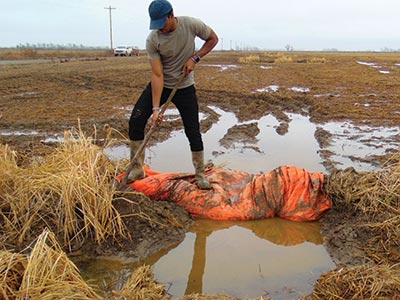
In the Delta region, rice is normally rotated with soybean. With furrow-irrigated rice, less land preparation and labor are needed because rice levees do not need to be removed before planting soybean. During the rice season, floodgates need to be monitored and adjusted. If a levee is not sufficiently packed before establishing a permanent flood, repairs by hand are often required (Figure 1).
Most fields in the mid-South are flood irrigated. Farmers pump water from a well on the top pan of a field long enough for it to cascade through the system of gates to fill the lower pans.
But managing pumps is tricky. Moreover, electric power companies discourage running pumps during peak hours. A delay of several hours can occur between the time the pump is shut off and the time at which water reaches the bottom pan. Despite a farmer’s best effort, inevitably the pump is often left on too long and water is wasted.
A variation on the flood method is side-inlet irrigation, which uses lay-flat plastic pipe placed at the field edge or across the levees to fill pans all at the same time. Less guesswork with stopping the pump is needed with this method. A demonstration by the U.S. Department of Agriculture (USDA) Natural Resource Conservation Service showed that side-inlet irrigation saved 39% in energy and 60% in irrigation water compared to cascade flooding.
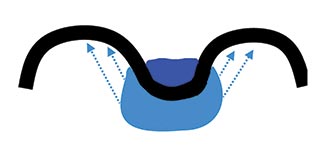
Furrow irrigation can also use less water than cascade flooding, depending on how it’s managed. Growers are encouraged to use soil moisture sensors and weather-based soil water balance programs for scheduling furrow irrigations in order to conserve water resources.
Sam Atwell, a rice extension agronomist, observed in a farm survey that some rice farmers were more successful than others at growing rice with furrow irrigation. He credited that in part to differences in management style but saw that soil texture and bed width in fields played a major role in producing high yields.
Generally, Atwell found that irrigation water “wicked” to the center of beds on clay soils better than loam soils (Figure 2). In fields with silt loam soil and wide 60-inch beds, the rice on top of the beds was shorter in height and produced less grain than rice in the water furrows. Row beds should be made only as high as necessary to keep irrigation water in furrows (Figure 3).
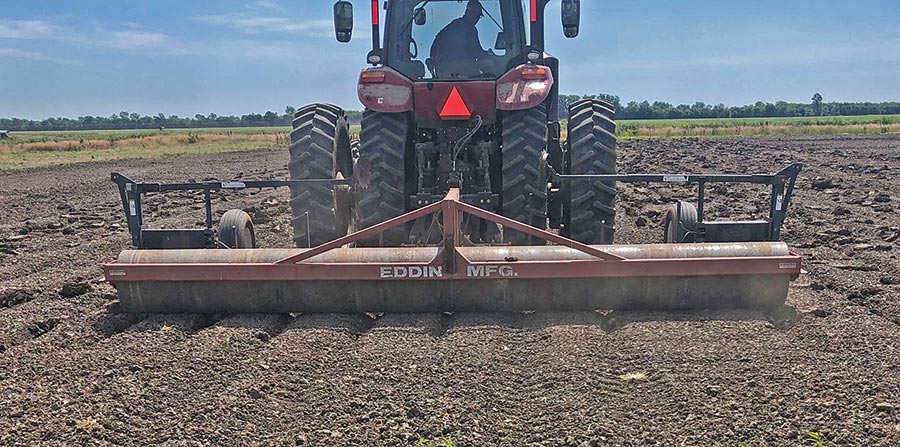
Site selection and land preparation
Field grade is the most important factor in choosing and preparing a field for furrow-irrigated rice. Precision-graded land is best, but may not be needed on short-run fields. Most land furrow-irrigated for corn or soybeans in the past is adequate. Water must run down every furrow. Skipped furrows or poorly graded land creates potential for water stress and yield loss.
Harvest equipment can cause tire ruts in the fall that need to be smoothed. Field preparation often starts with a disk (or disc). A single disking prior to bed preparation usually is adequate behind a low-residue crop such as soybeans. Following corn or rice, more passes may be required.
After disking, raised beds should be built using a bed conditioner hipper or furrow plow. Most hipping equipment is set at 30- or 38-inch spacings between raised beds. Either spacing can be used for furrow-irrigated rice. Spacings greater than 38 inches will not provide adequate conditions unless soils allow good lateral wicking action of irrigation water (Table 1).
Table 1. Rice yields from three bed widths on Sharkey clay soil at the University of Missouri Fisher Delta Research Center in Portageville, Missouri.
| Bed widths, in inches | Rice yield, in bushels/acre† |
|---|---|
| 30 | 165 a |
| 38 | 159 ab |
| 60 | 150 b |
| † Yield values followed by the same letter were not significantly different at the 0.05 level. | |
Bed spacing and height may differ by soil texture, and should be established to allow complete soil saturation across the entire soil surface (including ridgetops) after each irrigation. Bed height must be tall enough to prohibit irrigation water from breaking over bed tops.
A tail levee should be constructed after planting or stand establishment. Levees prevent water loss and maintain near-flooded conditions at the field’s lower end. Side levees 50 feet to 400 feet in length can be built if the field has considerable side slope, and will prevent water from becoming too deep at low corners.
Planting practices
Planting rice seed with a grain drill is recommended over broadcasting seeds. The greatest benefit of drilling is accurate seed placement. Grain drills respond with better placement on 38-inch bed spacings compared to 30-inch bed spacing because of more gradual microrelief. Rice may have poor epicotyl strength (pushing power) and difficulty emerging through soil. Drill spacings of 7.5 inches and ½-inch seed depth placement have been successful.
The broadcast system leads to seed placement ranging from the soil surface to the depth of tillage and frequently leads to poor stand establishment. Broadcast seeding should only be done on loam or sandy loam soils that have little tendency to crust and with rice varieties that possess excellent stand establishment capabilities. Drilling is recommended on all soils, especially on clay or clay loams.
Seeding rate should be equal or slightly higher in furrow-irrigated compared to flooded rice fields, and will be variety-dependent. Seeded rates of 100 to 150 pounds (1.75 to 2.5 million seed) are usually optimum for furrow-irrigated rice.
Rice may need to be irrigated (flushed) immediately following planting unless rainfall is imminent. Flushing enhances seed germination, seedling emergence and early season crop growth. Furrow-irrigated rice fields can be flushed more quickly and efficiently than flooded rice fields. The downside of flushing is that lay-flat pipe must be rolled out early, and there’s more opportunity for holes or rips in the plastic from equipment crossing it.
Variety selection
Long-grain rice often grown under flooded conditions in Missouri can also be grown by furrow irrigation. Seedling emergence and vigor are key considerations in selecting varieties. Since the permanent flood is not used to aid in weed control, quick stand establishment and canopy closure is essential. The best adapted varieties possess excellent emergence, seedling vigor, canopy closure and weed competitiveness. Generally, rice varieties produce higher yields with flood irrigation than with furrow irrigation. However, tests at the Missouri Rice Research Farm showed that some lines, especially hybrids, can produce the same in both irrigation systems.
Lay-flat irrigation pipe
In the past, farmers used rigid aluminum pipe to apply furrow irrigation to crops in the Delta region. Around 1990, rigid pipe began to be replaced by flexible, plastic lay-flat pipe. The tubing is usually white in color and sold in large rolls. Generally, the thicker the mil of the plastic, the greater the pressure a pipe can handle without bursting. Most farmers use 9- or 10-mil thickness. A common type is a 15-inch diameter, 10-mil thickness that rolls out to a ¼-mile length and costs about $305 USD. It will handle up to 1,000 gallons per minute and 1.3 pounds per square inch pressure. Farmers with new wells are using 18-inch diameter pipe. Lay-flat pipe is usually installed with a “polypipe roller” implement which is mounted on the three-point hitch of a tractor. One end of the tubing is attached to a well pipe with nylon zip ties and duct tape. The tractor moves slowly across the end of the beds on the high end of the field. The roller has a small plow which cuts a groove in the soil, and the lay-flat pipe is rolled out in the trench. The shallow trench helps keep the tubing from shifting when irrigation water is pumped into it. It is best to install lay-flat pipe on a calm day to prevent the empty pipe from blowing away before it can be filled with water. After the pipe has water in it, wind is usually not a problem.
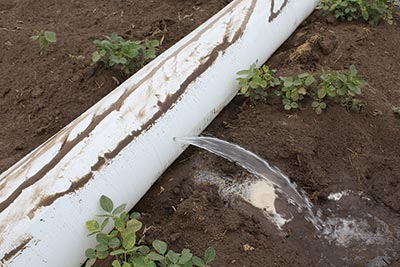
The well should be started and water pumped into the pipe as soon as possible. After water reaches the open end of the pipe, a knot is tied in it. As water pressure increases in the pipe, holes are quickly punched in the plastic pipe at every furrow to avoid letting the pipe explode. To obtain even water flow across the field, small holes are punched near the well where pressure is highest (Figure 4). Hole sizes should be made progressively larger going away from the well. Computer programs such as the Pipe Hole and Universal Crown Evaluation Tool (PHAUCET) developed by the USDA Natural Resources Conservation Service or Pipe Planner by Delta Plastics can be used to determine the optimum hole sizes to punch at each furrow.
In large fields, it may be difficult to maintain enough pressure in long runs of plastic pipe. To solve the problem, fields can be divided into sections with pipe gates opened and closed to irrigate one area at a time or in equal blocks in a split-set configuration using a programmable surge valve. Irrigation with surge valves is usually done in two stages. The first stage advances water in furrows across the field in the shortest possible time. The second stage cycles water sets to improve infiltration in soil on the upper end of a field. A tail levee helps avoid losing water to runoff.
Researchers have found that the reproductive stages of rice are the most sensitive to water stress. Alternating wetting and drying by irrigation in rice vegetative stages did not reduce yields if flooding was maintained from panicle initiation through harvest. In treatments where wetting and drying cycles were done the entire season, methane emissions were reduced 93% compared to continuously flooded rice.
Irrigation scheduling
Rice is less forgiving than other crops when irrigation water is applied too late or in insufficient amounts. Most irrigation decisions by farmers are made by looking at the crops or soil. A national survey showed that 44% of farmers scheduled irrigation on fields based on visual condition of the crop, and 25% checked the feel of the soil. Only 3% used daily crop evapotranspiration (ET), and 3% used soil moisture sensors. Another 3% of the survey respondents said they began irrigating when they saw their neighbor start.
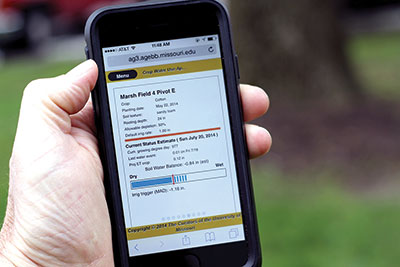
Irrigation scheduling programs are useful tools for improving water efficiency in furrow-irrigated rice. Several state extension services have developed mobile phone apps linked to electronic weather station networks to calculate evapotranspiration (ET) used for irrigation scheduling. Obtaining daily data is a challenge for farms located outside weather station networks. In a two-year study, we compared electronic atmometers (ETgages) to weather stations. The ETgages showed good accuracy at one-tenth the cost of a station in supplying daily ET estimates.
Most state extension irrigation apps use the same algorithms to calculate daily soil water balances. The complex calculations are not displayed to users in most irrigation apps. The Penman-Monteith equation is usually used to estimate standardized short-grass evapotranspiration, called ETo. The first version was developed in 1948 by Howard Penman and other engineers have fine-tuned it over the years. ET is the combination of transpiration from the crop and evaporation of the water from the soil or plant surfaces. The University of Missouri Extension service maintains an agricultural weather station network (mesonet) that provides weather data to farmers for managing irrigation. The weather stations must meet standards approved by the American Society of Agricultural Engineers. Most of the 34 stations in the mesonet have a Campbell Scientific CR-1000 data logger that is programmed to calculate ETo. For farmers calculating daily crop ET for irrigation scheduling, ETo is multiplied by a coefficient (Kc) specific to the crop in the field. In the Northern Hemisphere, ETo is usually highest in June or July, when days are longer. ETo varies from year to year, which is a limitation for irrigation scheduling from printed charts that rely on long-term weather averages.
Farmers do not have time to manually calculate daily crop ET and soil water deficits from weather data for their fields. The main difference between extension irrigation apps is their interface design and ease of use. Growers usually just want to know which fields on their farm need irrigation today or in the coming week. Predictions such as crop growth from temperature are important but secondary.
The University of Missouri Extension service released an irrigation app for mobile phones called the Crop Water Use app, which uses daily ETo from the state mesonet (Figure 5). Many of the equations in the Missouri program, including crop coefficients, were modified from the Arkansas Irrigation Scheduler. A crop coefficient for non-flooded rice was made working with scientists at the University of Arkansas and the USDA-Agricultural Research Service.
Irrigation frequency is impacted by the app settings selected by the farmer. In the Missouri program, soil available water holding capacity, rooting depth and percent allowable depletion determine the irrigation trigger. Fields with sandy soils with low available water holding capacity trigger faster and need smaller amounts of irrigation water more frequently than medium-textured soils. In a field trial with furrow rice on silt loam soil, we found that setting the rooting depth at 12 inches in the app produced the highest grain yields (Table 2).
Table 2. Irrigation applications and rice yields for three root depth triggers in the Crop Water Use app for furrow-irrigated rice at the Missouri Rice Research Farm in Qulin, Missouri.
| Rooting depth trigger, in inches | Irrigations, number | Total water in season, in inches | Rice yield, in bushels/acre† |
|---|---|---|---|
| 6 | 15 | 30 | 178 c |
| 12 | 11 | 22 | 192 a |
| 18 | 7 | 14 | 186 b |
| † Yield values followed by the same letter were not significantly different at the 0.05 level. | |||
A possible explanation for the significantly lower yields with the 6-inch root setting is that more nitrogen was lost by denitrification compared to treatments with less water. Averaged across irrigation trigger treatments, the lowest yield occurred in the upper parts of the test field.
The lower part of the field had standing water part of the time because of water held back by the end levee (Table 3).
Table 3. Rice yields from three locations in furrow irrigated field averaged across irrigation trigger treatments at the Missouri Rice Research Farm in Qulin, Missouri.
| Field location | Rice yield, in bushels/acre† |
|---|---|
| Upper | 171 c |
| Middle | 185 b |
| Lower | 200 a |
| † Yield values followed by the same letter were not significantly different at the 0.05 level. | |
Nitrogen management
Prior to the last decade, most farmers in the Mississippi River Delta region split nitrogen fertilizer between two or three applications in the season on flood-irrigated rice. A typical program was 90 lbs. N/acre applied immediately before flooding at the 5-leaf stage and 30 lbs. N/acre applied at internode elongation (IE), followed by 30 lbs. N/acre two weeks later.
Now many farmers apply all the nitrogen before flooding. A nitrogen test was conducted to evaluate the timing of nitrogen applications on furrow-irrigated rice at four stages of growth. Total nitrogen ranged from 90 to 225 lbs. N/acre (Table 4). Results showed that treatments that included 45 lbs. N/acre applied two weeks after IE produced more rice than other treatments.
Table 4. Rice yields from nitrogen treatments at 5-leaf, internode elongation (IE), IE + 2 weeks and boot growth stage at the Missouri Rice Research Farm in Qulin, Missouri.
| ------------Application timing------------ | |||||
|---|---|---|---|---|---|
| 5-leaf stage | Internode elongation | IE + 2 weeks | Boot | Total N | Rice yield, in bushels/acre |
| ------------Pounds N/acre------------ | |||||
| 45 | 45 | 0 | 0 | 90 | 178 c |
| 45 | 45 | 45 | 0 | 135 | 188 b |
| 45 | 45 | 0 | 45 | 135 | 177 c |
| 45 | 45 | 45 | 45 | 180 | 196 a |
| 90 | 45 | 0 | 0 | 135 | 182 c |
| 90 | 45 | 45 | 0 | 180 | 192 ab |
| 90 | 45 | 0 | 45 | 180 | 180 c |
| 90 | 45 | 45 | 45 | 225 | 191 ab |
| † Yield values followed by the same letter were not significantly different at the 0.05 level. | |||||
Insect control
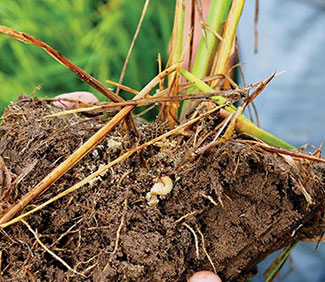
Seed treatments are important for controlling early season infestations of grape colaspis, rice water weevil and billbugs.
Billbugs are usually not a problem in flooded rice but can be devastating in furrow-irrigated rice. In the spring, billbug adult females lay eggs in rice stems near the soil surface. The larvae feed on rice roots, causing blank panicles, also called whiteheads (Figure 6).
CruiserMaxx Rice or NipsIt Inside is used in seed treatments for grape colaspis and water weevils in flooded fields. A University of Arkansas study showed that they can also be used effectively in combination with Fortenza or Dermacor for billbug control in furrow-irrigated rice. Rice fields should also be scouted for nymphs and adult stink bugs and sprayed if they exceed thresholds.
Weed control
The most difficult weed to control in furrow-irrigated rice is Palmer amaranth pigweed (Amaranthus palmeri). In most fields, clomazone applied preemergence and propanil + quinclorac + halosulfuron applied when pigweeds reach 2-4 leaf stage works well. If more pigweeds emerge later, another application of propanil + quinclorace or acifluorfen + bentazon can be made.
Saflufenacil (Sharpen™) is an inhibitor of protoporphyrinogen oxidase (PPO inhibitor) used in postemergence spray applications before panicle initiation. In Missouri trials, Sharpen was effective for broad spectrum weed control but caused significant leaf burn at one location. Additionally, with the advent of PPO-resistant Palmer amaranth, this herbicide may become obsolete.
Florpyrauxifen-benzyl (Loyant™) is a broad spectrum arylpicolinate rice herbicide from a new class of chemicals. Unfortunately, it has not been consistent from year to year. It works best under warm, sunny conditions and with high soil moisture in a flooded rice environment. But it can still be a useful tool for sedge and broadleaf control in furrow-irrigated rice.
At the University of Missouri-Fisher Delta Research Center, herbicide treatments were applied to plots in replicated, randomized complete blocks. Chemicals were applied postemergence in early July. Each plot was visually rated both six days and 21 days after treatment. Treatments were:
- Untreated check
- Propanil
- Loyant
- Sharpen
- Grandstand™
The primary weed in the plots was Palmer pigweed. Loyant did an excellent job of killing even large pigweeds with less crop injury than Sharpen. Loyant also provided control of many grass weeds, such as barnyardgrass and panicum species, in addition to control of rice flatsedge, smallflower umbrella sedge and yellow nutsedge. Propanil and Grandstand stunted or burned pigweeds, but most recovered and grew back later in the season.
Growers should be aware that Loyant does not perform this well every year (Figure 10).
Disease control
Rice breeders typically select for progeny with increased yield potential and resistance to sheath blight caused by Rhizoctonia solani (Kuhn) and blast disease, Pyricularia grisea (Cavara). Blast which spreads by wind-borne spores is the main concern of farmers growing furrow-irrigated rice. Sheath blight is spread by floating spores in floodwater, which does not apply to furrow irrigation. Blast control practices — such as planting cultivars rated with good resistance or applying fungicides — are not always enough to prevent the disease. Currently, there are no commercial cultivars in the United States that are 100% resistant to the disease. Neck and panicle blast can also be devastating. Strobilurin fungicides can be applied to help control blast beginning at 10% heading, according to labels. Crop rotation and straw management between growing seasons helps control the disease, but blast can mutate to a different race and cause serious injury to a previously resistant rice variety. Scout fields closely and apply fungicides before the disease becomes severe.
Plot photos from herbicide treatments for center pivot rice
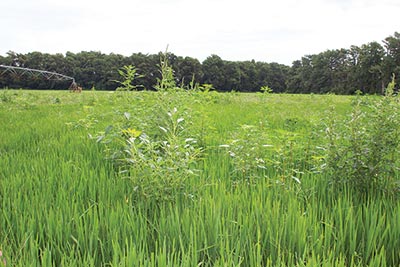
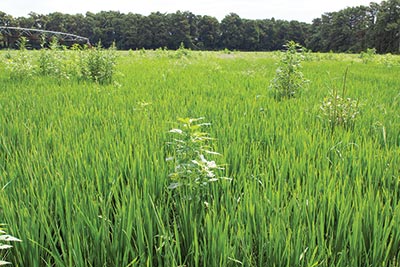
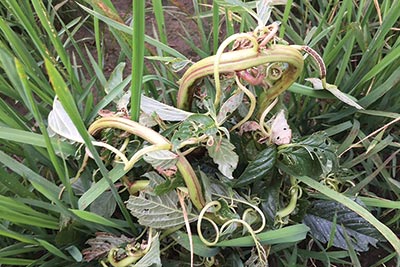
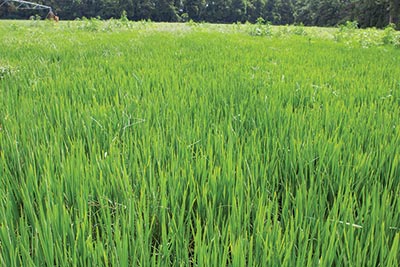
Conclusions
Rice can be produced in Missouri using furrow irrigation. Levees are not needed, which saves on time and labor. Furrow irrigation is not intended to replace floodwater rice production but to serve as an alternative in situations where labor is limited. Furrow irrigation may be appropriate when a farmer is expanding rice acreages into nontraditional rice soils, in areas where water is limited or when irrigation pumping costs are excessive.
As with any new management system, rice growers who intend to furrow irrigate should do so on small acreages for one to three years until they are confident that it fits into their farming operation.
The Missouri Rice Research and Merchandising Council and the USDA-Natural Resource Conservation Service contributed funds and resources for information discussed in this publication.